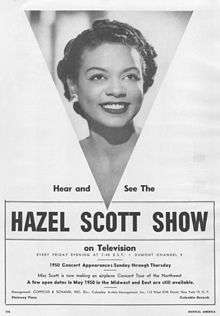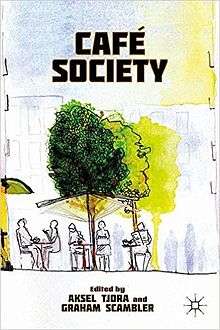Café society

Café society was the portrayal of the types of people who were given the title by the tabloids of “Beautiful People” and “Bright young things" who gathered in fashionable cafes and restaurants in New York, Paris and London beginning in the late 19th century. Maury Henry Biddle Paul is credited with coining the phrase "cafe society" in 1915. Lucius Beebe created the term "chromium mist" for the cafe society lifestyle he chronicled in his weekly column, "This New York," for the New York Herald Tribune during the 1920's and 1930's.[1]
These wealthy aristocrats attended each other's private dinners and balls and took holidays in exotic locations at elegant resorts. In the United States, café society came to the fore with the end of Prohibition in December 1933 and the rise of photojournalism. Photographers began to describe the set of people who tended to do this entertaining semi-publicly, in restaurants and night clubs and the types of people who would include among them such as movie stars and sports celebrities.[1]
Some of the American night clubs and New York City restaurants frequented by the denizens of café society included El Morocco, the Stork Club, Restaurant Larue, and the 21 Club. A complete history of New York café society was published by McFarland Publishing in 2015.The book is illustrated with photographs by Jerome Zerbe.[2]
In the late 1950s the term "Jet Set" began to take the place of "café society," but "café society" may still be used informally in some countries to describe people who habitually visit coffeehouses and give throw parties in restaurants rather than at home.
"Terms/lingo" in the scene
- "Jet Set" - Fashion forward, wealthy socialites who travel in jets to parties and events.[3]
- "Bright Young Things" - Name given by the press to young, wealthy socialites who dressed in lavish clothing and would go to expensive parties to indulge in alcohol and drugs.
- "Beautiful People- Another title similar to "Bright Young Things".
- "Chromium Mist"- Term created by Lucius Beebe for this type of lifestyle.
Cafe Society: The Wrong Place for the Right

Barney Josephson a former shoe salesman who opened two high-end night clubs in the prime time of race equality and the prohibition. Both nightclubs, which were documented as "historical", were opened up in New York between the years of 1938 and 1940. Both clubs were named Café Society and Café Society (Uptown). Josephson later wrote a bibliography called "Cafe Society: The Wrong Place for the Right People", which was written as a first hand experience about running a radical nightclub, the interesting individuals that attended the club, its importance on race equality and its direct influence on the Jazz community. The constant revolving doors of the two nightclubs allowed many interesting ideas, beliefs and values to be acknowledged under the same roof. An important variable that never changed was the immense amount of jazz musicians to walk through the doors. These two nightclubs were one of the few venues to allow interracial mix in the audience. Barney Josephson paved a way for musicians, actors and all races alike to join in and indulge in performances unlike no other. A few stars to have been seen in Josephson's club were Billie Holiday, Hazel Scott, Zero Mostel, Albert Ammons, and Pete Johnson.[4]

“Tell your friend to call it Café Society”
Barney Josephson wanted a unique nightclub, nothing like anyone has seen before. No photographers allowed among the club-goers, and only fine art on the walls. Josephson asked a close friend, Sam Shaw, to help choose the artists who would help decorate and paint the insides of the nightclub. The artists were given absolute freedom, and were asked to choose a space and create any form of art that was desired. Each artist was paid $125 each and were supplied with canvases, panels and all the materials to work with. These individuals single-handedly made the nightclub the famous establishment that it was soon to be known for.[5]
Artists who created the café society
- Adolph Dehn- Was an artist whose advanced lithographs paved way for a new way of print-making.
- Sam Berman- The originator of the trade mark used on the cover of the Esquire magazine. He sculpted the figured called “Esky” which was supposed to be a “wealthy club goer”.
- Ad Reinhardt- An abstract artist who painted a large mural for the club that satirized the current fashion.
- Alice Stander- A really good artist who was married to the Hollywood actor Lionel Stander.
- Abe Birnbaum- Was known to have discovered the legendary editor of the New Yorker magazine, Harold Ross.
- Syd Hoff- A New Yorker cartoonist who later became a famous children’s book writer and illustrator.
- John Groth- Was an art editor and cartoonist for the Esquire Magazine, who also drew political cartoons for the New Yorker magazine.
- Gregor Duncan (artist)- At the time very little was known besides being a young inspiring artist.
- Christina Malman- Famously drew over thirty-five New Yorker covers and over five hundred drawings for the magazine.
- Colin Allen- Was the individual who captured the nightclub with humorous newspaper ads and also designed the covers for the match-books given out within the club.[6]
At the time a well-known gossip columnist by the name of Cholly Knickerbocker would write about the wealthy, aristocratic crowds who were nicknamed as the “café society”. Barney Josephson’s friend Clare Boothe wanted a political and social satire twist for the nightclub’s name and helped eventually helped accomplish that. “We’re calling this place Café Society. You guys can do anything you want to satirize the crowd and politics”-Barney Josephson.[6]

Jazz influence
Hazel Scott, born on June 11, 1920 in Trinidad was known as one of the pioneers of jazz music and was a radical women who challenged the race roles in music and media. Scott never second guessed her abilities as a talented African American, and never took roles that didn't show case her true skills. Scott's career blossomed with the help of Barney Josephson by performing her jazzy renditions of "modern" songs in both of his unconventional night clubs. Jazz was known to have been originated from New Orleans and created by mainly African Americans about their soulful experiences throughout history. Having been allowed to perform freely in Cafe Society allowed many other musicians to come in through the doors and enjoy the same musical freedom she had. Cafe Societies were also popularly known as "speakeasies", which instilled a secretive meeting place for all races and genders to enjoy music and perform their own songs in a predominately white oriented neighborhood. These types of nightclubs began to bloom with business at the start of the prohibition area. The secretiveness and mysterious ambiance made it the number one place to be for the wealthy to open up and waste the night away. [7]
Cafe community

The café society movement continues to grow and evolve its own form of different "types" of people one would see at a coffee shop. In 2007 a group of writers interviewed and studied many cafe customers and created six different types of people that would commonly enter a coffee shop. With a total of seventy interviews conducted and thirty-two observations in fourteen different cafés the writers created a "Cafe Community". [8]
The Six Types of People You Meet at a Cafe
- The Takeaway Customer
- The type of person who needs a caffeine-fix every day at least one time, usually in the morning. This type of person stops quickly at a cafe and leaves. No social interaction, and usually are prepared with what will be ordered. This type of person will eventually reach the level of becoming a "regular".[8]
- The Regulars
- Regulars are a diverse group who provide a certain "feel" and set a type of "tone" to the cafe. A regular would be a customer who is comfortable and understand the cafe from its physical aspects to it social aspects. A regular typically will not visit other cafes, and stick to just one.[8]
- The Café Worker
- This type of person uses the cafe as their work place or study hall. Typically seen with a laptop or doing some sort of work inside the cafe shop. In this modern era most cafes have free Wi-Fi allowing it to be an easy place to grab a coffee and do work.[8]
- The Loners
- Loners are known to visit cafes on a regular basis alone. Through the writers observations, the loners seem to find a sense of belonging in a cafe. Some seem to find going to a cafe alone a place to sanctuary, a place to relax and gather one's thoughts. In social setting such as a cafe shop, it allows the customer to be in tune with the outside world yet still have a sense of solitude.[8]
- The Social Guest
- People who directly plan to attend a cafe for the social interaction it offers. Typically use a cafe to keep social ties with friends and family in a outside setting. The cafe is seen as a hub for any type of social engagement that can involve a shared meal, a deep conversation or even a quick coffee. Its a social space with a relaxing atmosphere that allows this type of customer to feel comfortable to interact with others.[8]
- The Mothers
- The last type of customer title given by the writers is "The Mothers". Cafe's have seem to be a meeting place for many "new mothers" who have either joined a "social mother's group" or a place to simply interact and meet other mothers in the same situation. Some cafe's are even known to create "meet-ups" for mothers to meet on a weekly basis to discuss among themselves.[8]
References
- 1 2 De Ocampo, Brooke (2002). Bright Young Things. Assouline. pp. New York. ISBN 2843233372.
- ↑ Young, Anthony (2015). New York Cafe Society. Jefferson, NC: Mcfarland & Company Inc. ISBN 0786474378.
- ↑
- ↑ Trilling-Josephson, Terry (2009). Cafe Society. Library of Congress Cataloging-in-Publication Data. ISBN 9780252034138.
- ↑ Trilling-Josephson, Terry (2009). Cafe Society. Library of Congress Cataloging. pp. 23–25.
- 1 2 Trilling-Joshephson, Terry (2009). Cafe Society. Library of Congress Cataloging. pp. 24–29.
- ↑ Mack, Dwayne (1 January 2006). "Hazel Scott: A Career Curtailed". The Journal of African American History. 91 (2): 153–170. JSTOR 20064068.
- 1 2 3 4 5 6 7 Tjora, Aksel (2013). Cafe Society. NY, NY: Palgrave Macmillan. pp. 89–99. ISBN 9781137275929.
Bibliography
- Beebe, Lucius (1967). Charles Clegg and Duncan Emrich, eds. The Lucius Beebe Reader. Garden City, N.Y.: Doubleday & Company. OCLC 720851.
- Blumenthal, Ralph (2000). Stork Club: America's Most Famous Nightspot and the Lost World of Café Society. Boston: Little, Brown & Co. ASIN 0316105317. ISBN 0-316-10531-7. OCLC 42072089.
- http://www.dictionary.com/browse/jet-set "The Definition of Jet Set." Dictionary.com. N.p., n.d. Web. 01 Nov. 2016.
- Jonathon Bakan (2010). "Cafe Society: The Wrong Place for the Right People (review)". Notes. 67: 96. doi:10.1353/not.2010.0033.
- Josephson, Barney, and Terry Trilling-Josephson. ""Tell Your Friends to Call It Cafe Society"" Cafe Society: The Wrong Place for the Right People. Urbana: U of Illinois, 2009. N. pag. Print.
| Look up café society in Wiktionary, the free dictionary. |